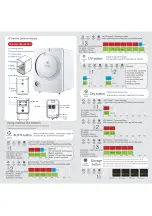
Note
•
The time interval from initial stimulus perception to inability to hear the tone.
6. Strike the fork again.
7. Hold the fork for 2-3 seconds and then place it in front of the patient's ear.
Note
•
The time interval from initial stimulus perception to inability to hear the tone.
8. If air conduction perception is better than bone conduction, this is a positive Rinne and agrees with normal hearing
9. If bone conduction perception is better than air conduction, this is a negative Rinne and indicative of a conductive
hearing loss.
10. If air conduction and bone conduction are equal, this is a positive Rinne and indicative of a sensorineural hearing loss.
11. Store the test result in the
Rinne
Box.
5.2.6
Performing Alternate Binaural Loudness Balancing (ABLB) test
If you have measured thresholds prior to performing ABLB, then these will appear already plotted in the ABLB graph.
1. Properly place the earphones.
2. Give the patient the responder(s).
3. Instruct the patient so that he/she knows what to expect: "You will hear a continuous tone. The level of this tone will
be changed periodically. Press the button on the responder immediately each time you hear a change. I will ask you if
the test tone is softer than, louder than or equal to the reference tone in the opposite ear."
4. Choose the ABLB tab or select ABLB in the Test Selector.
–
Make sure that the control panel of the Otosuite software is set to the correct transducer and desired routing.
–
If left ear is selected as the test ear in the Control Panel Routing section, then the right ear will be the reference
ear.
5. Set the reference level (
Ch 1
).
6. Set the test level (
Ch 2
) to 10 dB above the patient's threshold for that ear.
7. Adjust the level of the test signal (
Ch 2
) until the patient reports that the two signals sound equally loud.
8. Store the data points.
9. Repeat steps
to
for additional frequencies.
10. If desired, switch routing to test the opposite ear and repeat steps
to
.
5.2.7
Performing Short Increment Sensitivity Index (SISI) test
1. Properly place the earphones.
2. Give the patient the responder(s).
3. Instruct the patient so that he/she knows what to expect: "You will hear a continuous tone. The level of this tone will
be changed periodically. Press the button on the responder immediately each time you hear a change."
4. Choose the
SISI
tab or select
SISI
in the Test Selector.
–
Make sure that the control panel of the Otosuite software is set to the correct transducer and desired routing.
Madsen A450
69
5 Examples of audiometric testing
















































